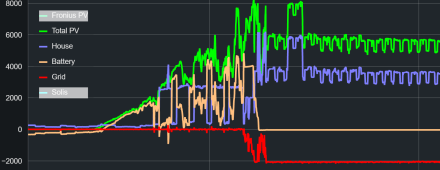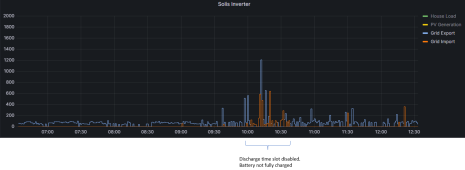I currently have the Solis RHI-6K-48ES-5G hybrid inverter which I am connecting remotely from a Raspberry PI via the Modbus.
I want to be able to automate the power exported to the grid, depending on the state of charge of my battery.
i.e. 0 export when battery State of Charge (SOC) is <90%, some positive export as the the battery becomes fully charged.
I had expected this to be the default operation of the inverter itself. If you have a battery why would you want to export to the grid when your battery is not fully charged !! But surprisingly this is not how the Solis inverter operates. If you set a positive export, "Backflow Power" as it is called in the solis menu, this export is maintained regardless of the battery SOC. [ edit : @peufeu has shown in the thread below that this is actual incorrect. You can programme the inverter to only export when the battery SOC is 100% by enabling optimum income and disabling a discharge timeslot]
[ edit : @peufeu has shown in the thread below that this is actual incorrect. You can programme the inverter to only export when the battery SOC is 100% by enabling optimum income and disabling a discharge timeslot]
But I need the 40XXXX modbus holding register that writes the backflow power .
Found only one modbus map online that indicates that the input read register could be 306508, here
Before I do a complete read of all 40XXXX registers and try and reverse engineer it, does anyone have a map which specifies the backflow register number or achieved what I want to do remotely ?
Many Thanks to @peufeu who has given me the correct answer in this post. The answer is Modbus register 43074
I want to be able to automate the power exported to the grid, depending on the state of charge of my battery.
i.e. 0 export when battery State of Charge (SOC) is <90%, some positive export as the the battery becomes fully charged.
I had expected this to be the default operation of the inverter itself. If you have a battery why would you want to export to the grid when your battery is not fully charged !! But surprisingly this is not how the Solis inverter operates. If you set a positive export, "Backflow Power" as it is called in the solis menu, this export is maintained regardless of the battery SOC.
But I need the 40XXXX modbus holding register that writes the backflow power .
Found only one modbus map online that indicates that the input read register could be 306508, here
Before I do a complete read of all 40XXXX registers and try and reverse engineer it, does anyone have a map which specifies the backflow register number or achieved what I want to do remotely ?
Many Thanks to @peufeu who has given me the correct answer in this post. The answer is Modbus register 43074
Last edited:




